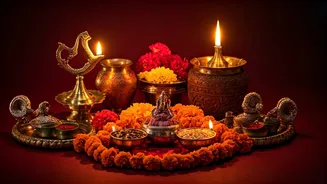Selecting a Space
The first step in establishing a puja altar for Diwali involves selecting the perfect location within your home. It’s important to find a spot that’s clean,
tranquil, and free from everyday interruptions. A dedicated room or a quiet corner that you designate specifically for prayer and meditation is ideal. Ensure the area is well-lit, either naturally or with adequate artificial lighting. The location should also be easily accessible, encouraging regular worship during the festive season. You may want to consider a space away from the main thoroughfares of your home to minimize noise and maintain a sense of sanctity. Ensuring the location's purity and peace is vital for creating a spiritually conducive environment.
Deity Placement
Once you have selected the location, the next step involves arranging the deities. Place the idols or pictures of the deities you worship on the altar. Typically, the central figure is placed at the front or center to receive the main focus of devotion, flanked by other significant deities or figures related to Diwali. Arrange the idols in a visually appealing and organized manner, considering their relative importance. Make sure that the placement of the idols is based on traditional layouts, such as those that might be recommended by your family traditions. The direction of the idols can also be significant. Many people arrange the deities facing east, toward the rising sun, to bring in positivity. Proper deity placement is crucial in creating an altar filled with reverence and auspiciousness.
Essential Items
To complete your puja altar, you’ll need to add some key essential items. Begin with a clean, decorative cloth or mat to cover the surface of the altar. Ensure that you have lamps (diyas) or oil lamps to create light during the ceremony. Include incense sticks or cones and an incense holder to help perfume the air. Consider having a bell or a small instrument to create a rhythmic sound during prayers, and also a small container for holy water (Gangajal). In addition, arrange flowers, fruits, and sweets, as these are typically offered as part of the prayers. A book of mantras or devotional songs can assist in the devotional practice. Ensure you have the necessary items to offer your prayers to create an authentic experience.
Adding Symbols
Incorporate various symbolic elements to add significance to your Diwali puja altar. These symbols are essential to the rituals and the devotional impact. Include the image of the goddess Lakshmi, the deity of wealth and prosperity, and Lord Ganesha, the remover of obstacles. Also, decorate the altar with marigold flowers, lotus flowers, and other colorful blooms. Hang decorative lights like string lights or fairy lights to illuminate the space. Consider placing the swastika symbol, considered auspicious, in a prominent position. Other symbols like the Om symbol, diyas (lamps), and rangoli (decorative patterns) also add to the sacred environment. Be intentional while including each element to imbue the atmosphere with positivity.
Final Touches
After arranging all the components, add a few finishing touches to perfect your Diwali puja altar. Maintain an orderly and pristine appearance. Remember to keep the altar clean and neat by removing anything that's not needed for the puja. Regularly wipe down the surface. Ensure that the lamps are lit safely and continuously throughout the puja. Play devotional music or chants to boost the atmosphere. Be prepared with offerings like sweets and fruits. Before the Diwali celebrations commence, the setting should be inviting and in harmony with the spiritual purpose. Taking these steps makes the experience more gratifying.



